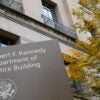President Obama publicly admitted Monday for the first time that the U.S. is conducting an aggressive drone missile campaign against terrorists predominantly located in Pakistan’s tribal areas bordering Afghanistan.
U.S. officials in the past have been tight-lipped about drones, partly out of deference to Pakistani officials, who are sensitive about U.S. attacks on its sovereign territory, and partly to avoid addressing international questions about the legality of remotely controlled attacks.
So why has President Obama chosen to speak openly about the drones at this juncture? U.S.-Pakistan relations remain deeply troubled, and President Obama’s statements are likely to fuel Pakistani public anger against the U.S.
One explanation could be President Obama’s desire to openly tout the success of the drone strikes in weakening al-Qaeda, especially as the 2012 U.S. presidential election approaches.
Several Administration officials, most notably Vice President Joe Biden, have tried to make a distinction between having a U.S. force presence in Afghanistan and conducting drone missile strikes, as if the two were mutually exclusive. Biden has proposed that the U.S. “off-shore” its counterterrorism operations by reducing U.S. force levels in Afghanistan and relying more on drones to address the terrorism problem in South Asia.
The reality is that in order to maintain an effective drone campaign, the U.S. must also have a force presence in the region. Intelligence access drives an effective drone campaign. The U.S. needs good intelligence to target terrorists and to limit collateral damage. If the U.S. withdraws combat forces from Afghanistan too quickly (i.e., before the recent gains against the Taliban are solidified and the Afghan army sufficiently trained and equipped), it will lose overall leverage in the region as well as the ability to conduct effective drone strikes.
If Taliban forces regain influence in Afghanistan, they are highly unlikely to allow the U.S. to stage drone strikes from Afghan territory or to allow the U.S. access to collect intelligence about targets. The Pakistanis already closed down the base from which the U.S. launched drone strikes into the Federally Administered Tribal Areas (FATA) following the November 26 NATO attack that killed 24 Pakistani soldiers, thus forcing the U.S. to launch drone strikes into the FATA from Afghanistan.
The effectiveness of the drone campaign is dictated largely by the degree of access the U.S. has in the region and the kind of relationships it has with the ruling governments. If the U.S. pulls its troops out of Afghanistan too quickly and/or fumbles the negotiation of a Strategic Partnership Agreement with the Karzai government that would allow the U.S. to sustain a troop presence after 2014, it will jeopardize its ability to continue effective counterterrorism operations in the region, such as the drone strikes.
Don’t be fooled by political rhetoric that makes a broad distinction between U.S. force presence and the drone missile campaign. Conducting an effective drone campaign in a region that is devoid of U.S. military presence would be an uphill—if not nearly impossible—task. U.S. negotiators would be wise to keep these realities in mind as they seek a political settlement with the Taliban leadership, who will surely press for an end to drone strikes.
The bottom line is that the U.S. needs to ensure that a friendly regime remains in Afghanistan after 2014 and that the U.S. establishes a sufficient long-term U.S. force presence there to keep terrorists at bay and on the run from U.S. drones.






























One Reply to “Hasty Afghan Troop Drawdown Could Jeopardize Drone Campaign”